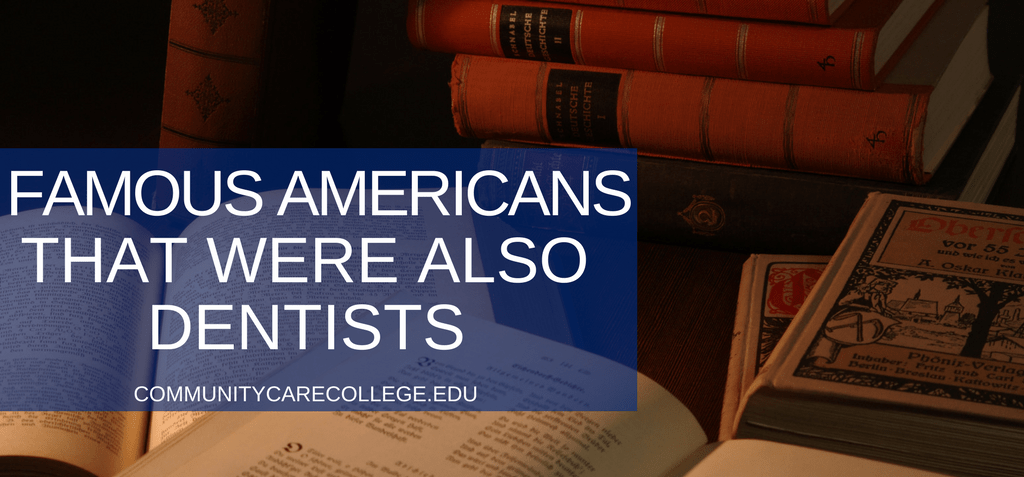Professional Dentists
From the desk of Janet Coon, Dental Assistant Department Head:
I wanted to reflect on a few Americans that were a part of this great profession of dentistry. Even though they may be famous for another reason, I tip my hat to the contribution they made to our field of educating, treating and preventing oral disease.
From Hollywood stars to historical figures and athletes so famous that Hollywood has told their stories over and over, these household names bettered our country while also bettering people’s dental health. Did you know these famous Americans were dentists?
Doc Holliday

John Henry “Doc” Holliday is famously known for pulling guns on people at the O.K. Corral – but before he gained gunslinging fame, he spent his time pulling something a little more mundane: Teeth. Prior to befriending Wyatt Earp and becoming deputized as a U.S. Marshall, the Wild West gambler led a quieter life practicing dentistry. A graduate of the Pennsylvania College of Dental Surgery, Doc graduated at the age of 20 and set up shop in Atlanta. Sadly, Doc’s tenure as a practitioner was cut short when he was diagnosed with tuberculosis, which caused him to have uncontrollable coughing fits at inopportune times. His practice slowly dried up, and he headed west hoping that the dry climate in the American Southwest would be better for his health.
Edgar Buchanan
A Western star of a different sort, Edgar Buchanan appeared in dozens of Wild West movies throughout the 1940s and ‘50s. However, the actor was probably best known for his work in “Green Acres,” “Petticoat Junction,” and “The Beverly Hillbillies.” The work he rarely gets credit for? His time as a dentist. Before becoming an actor, Buchanan earned his DDS degree from North Pacific College and had a dental practice with his wife Mildred, who was his classmate in dental school. The couple moved to California in 1939, where Buchanan caught the acting bug.
Jim Lonborg

It’s not often that you have a Cy Young award winner poking around in your mouth, but some patients in Massachusetts get to experience just that. Star baseball pitcher Jim Lonborg played for the Boston Red Sox from 1965 through 1971, and in 1967 became the first Red Sox pitcher to win the Cy Young Award. After a 15-year career, in which he played for the Sox, Brewers, and Phillies, Lonborg retired and enrolled in the Tufts University School of Dental Medicine. He became a dentist and set up shop in Hanover, Mass. Lonborg was inducted into the Red Sox Hall of Fame in 2002.
Paul Revere

He knew the British were coming, but Mr. Revere also knew a thing or two about dentistry. The famous midnight rider was also a silversmith, who studied under an English dental surgeon in the 1760s to learn how to make and insert false teeth. He used his craftsman skills to fashion dentures out of animal teeth or ivory to replace teeth that his 18th-century compatriots had lost. In addition to being an amateur dentist, Revere is also credited as the first forensic dentist. During the war, there were plenty of unidentified bodies. While examining remains in a mass grave after the Battle of Bunker Hill, Revere positively identified a body as that of Joseph Warren, based on a dental prosthetic he had made for the man several years earlier.
Mark Spitz

One of America’s most successful swimmers was very close to becoming one of the country’s most expertly mustached dental professionals. Mark Spitz was a pre-dental student at Indiana University from 1968 to 1972 – but seven gold medals in swimming at the 1972 Summer Olympics made him rethink his career path. “I always wanted to be a dentist from the time I was in high school, and I was accepted to dental school in the spring of 1972,” Spitz told Time magazine. “But after the Olympics, there were some other opportunities.” Sadly for the field of dentistry, 11-time medal-winning “Mark the Shark” was lured into the world of those “other opportunities,” i.e., television spots, endorsements, and commercials.










